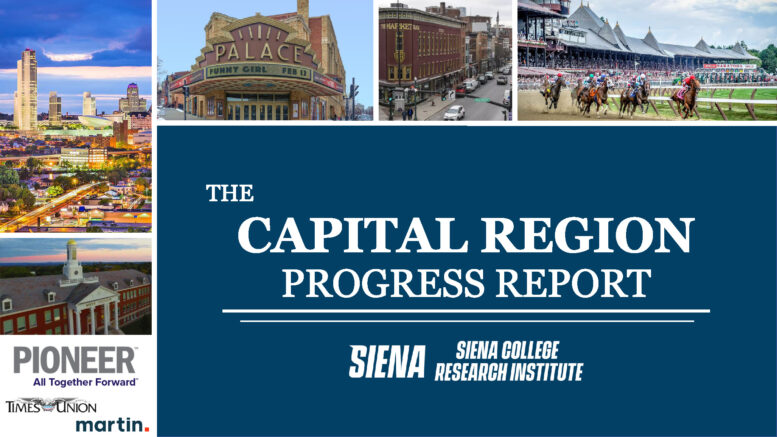- Housing Availability & Affordability Top Challenges; 47% Say Cost of Living Worse Here than Elsewhere; Still, 70% Say Jobs Paying Living Wage Available
- 89% Feel Safe and Secure; Majorities Give Good Grades to Education and Healthcare; Mixed on Opportunities for Business and Young People
- Cultural Assets – Performance Venues, Local Colleges, Recreational Opportunities, Airport Stand Out as Local Strengths
Press Release Crosstabs Presentation Event Booklet
Loudonville, NY. The Capital Region Progress Report Survey, a new measurement of life in the area, shows that while over two-thirds of residents of Albany, Rensselaer, Saratoga and Schenectady say the quality of life is either excellent (11%) or good (57%), by 38-25% they think that as a place to live the area is getting worse. The Siena College Research Institute (SCRI) with sponsorship from Pioneer Bank conducted this survey to provide area citizens and stakeholders with data on how citizens view local affordability, livability, opportunity and cultural assets in order to establish benchmarks and support progress.
Seventy-five percent of resident negatively rate the availability of local affordable housing and residents are split, 48-49% whether it is likely or unlikely that a typical person in the area can afford quality housing. Nearly half, 47%, say the cost of living in the Capital Region is worse, rather than better (23%), than it is in other areas that they are familiar with. Still, 70% say that it is at least somewhat likely that a typical person in our area can get a job that provides them with a living wage and 69% say that affordable adult education is available.
“Despite dramatic concerns about affordability, residents feel as though job training and jobs can be had in the Capital Region,” said Siena College Research Institute Director Don Levy. “And true to our nickname – SmAlbany, many say that the sense of community is what they appreciate most about the area. Overwhelmingly they say they feel safe and secure in their homes and that the police are doing a good job protecting citizens.
Eighty-nine percent say that residents feel safe and secure in their home and by 64-33% that the police are doing an excellent/good rather than only fair/poor job of keeping residents safe. A majority, 56-39% positively rate the quality of public education in the region but a larger majority, 65-31% negatively assess the responsiveness of local government.
“As far as livability is concerned, the Capital Region residents give the area high grades for healthcare both the quality of local hospitals and being able to obtain routine care,” Levy said. “On the other side of the ledger, traffic to some degree, how healthy and fit we are, public transportation and the weather detract from the local quality of life.”
“As a homegrown and locally headquartered institution dedicated to serving the Capital Region, we appreciate the expertise of the Siena College Research Institute in assessing the place we’re proud to call home,” said Tom Amell, President and CEO of Pioneer. “This report highlights the many strengths of our region, from quality of life and health care to cultural assets and a sense of community, while also noting areas we can improve, such as affordability. Importantly, it reinforces the need to work together to ensure a prosperous future for people, families, businesses throughout our region.”
Eighty-three percent think that it is likely that residents will receive a quality education for their children in the Capital Region and by 62-34% that it is an excellent/good rather than only fair/poor place to raise children. Over three-quarters, 77%, believe it is likely that a typical young person will graduate from high school. A small plurality, 46-41% say it is not likely that most residents that require it will be able to get quality affordable childcare.
“The Progress Report raises concerns for the future of young people in the region. Only 42% think it likely that a typical young person will be able to get a job with advancement possibilities and only 42% say it is likely that young people will be able to build a successful life here in the Capital Region,” Levy said. “Disturbingly, the same percentage, 42%, think it is likely that a typical local young person will end up abusing drugs or alcohol.”
“And despite the many strengths of the region – safety, education, healthcare – residents are evenly split, 48-48%, as to whether or not the Capital Region is a place right now where businesses can be successful,” Levy said.
“While Capital Region residents express concerns over affordability and point to both positive and negative components of local livability and opportunities, when it comes to cultural assets, residents see many strengths,” Levy said.
Eighty-eight percent say that local performance venues like Proctors, The Egg, SPAC or the Palace Theatre enhance the quality of life here in the Capital Region. Similarly, nearly 90% say the local colleges and universities enhance the quality of life and at least 80% say the nearby recreational opportunities as well as the Albany Airport are strong local assets. About two-thirds also say that the MVP Arena as well as the Saratoga Race Track add to our region’s quality. Local parks are viewed favorably 69-30%.
Progress Report Scoring
In order to both establish benchmarks and to compare the Capital Region to the nation as a whole, we simultaneously consider all questions in the four different areas of the Report – affordability, livability, opportunity and cultural assets. We describe the composite scores for each area just as a teacher might when you attend a parent conference. Scoring ranges from excellent to good to only fair to poor. The appendix provides all questions in each area scored across those categories.

###
This Siena College Poll was conducted January 6 – 14, 2025, among 1,096 Capital Region Residents. Of the 1,096 respondents, 688 were contacted through a dual frame (landline and cell phone) mode (408 completed via MMS-to-web text). Telephone calls were conducted in English and respondent sampling was initiated by asking for the youngest person in the household. Telephone sampling was conducted via a stratified dual frame probability sample of landline and cell phone telephone numbers weighted to reflect known population patterns. The landline telephone sample was obtained from ASDE and the cell phone sample was obtained from MSG. Interviews conducted online are excluded from the sample and final analysis if they fail any data quality attention check question. Duplicate responses are identified by their response ID and removed from the sample. Three questions were asked of online respondents including a honey-pot question to catch bots and two questions ask the respondent to follow explicit directions. The proprietary panel also incorporates measures that “safeguard against automated bot attacks, deduplication issues, fraudulent VPN usage, and suspicious IP addresses”. Coding of open-ended responses was done by a single human coder. Data from collection modes was weighted to balance sample demographics to match estimates for New York State’s population using data from the Census Bureau’s 2023 U.S. American Community Survey (ACS), on age, region, race/ethnicity, education, and gender to ensure representativeness. The sample was also weighted to match current patterns of party registration using data from the New York State Board of Elections. It has an overall margin of error of +/- 4.0 percentage points including the design effects resulting from weighting. Sampling error is only one of many potential sources of error and there may be other unmeasured error in this or any other public opinion poll. The Siena College Research Institute, directed by Donald Levy, Ph.D., conducts political, economic, social, and cultural research primarily in NYS. SCRI, an independent, non-partisan research institute, subscribes to the American Association of Public Opinion Research Code of Professional Ethics and Practices. For more information, call Dr. Donald Levy at (518) 783-2901. For survey crosstabs: http://www.Siena.edu/SCRI.





